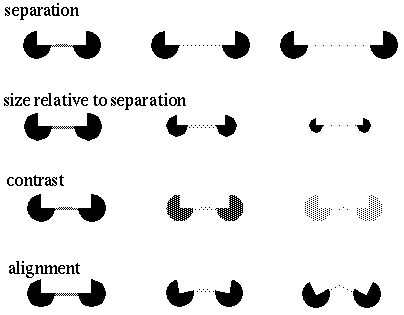Plato's Cave: Kanizsa psychophysics
Psychophysical Studies of the Kanizsa Figure
A number of parametric studies have been conducted to examine the
perceptual salience of the illusory boundary in response to various
factors. These studies have shown that the salience of the illusory
contour is a function of the length of the inducing edges relative to
the separation between them, [Banton & Levi, 1992] the contrast of the
inducers relative to the background, [Banton & Levi, 1992] and the
spatial alignment of the inducing edges [Kellman & Shipley, 1991].

Psychophysical experiments by Kellman and Shipley have revealed a
distinction between a bending mis-alignment and shearing mis-alignment
as shown below. While both forms of mis-alignment reduce the salience
of the illusory contour, the contour can survive a considerable
bending mis-alignment, but is far more sensitive to a shearing
mis-alignment.

Kellman and Shipley formalized these findings in a mathematical model
based on the linear extensions of the visible inducing edges. They
propose that edges whose extensions intersect at an obtuse angle are
relatable, i.e. capable of forming an illusory contour, while edges
whose extensions either fail to intersect, or do so at an acute angle
are non-relatable, as shown above. Note that for the purposes of this
definition, the linear extension is only defined beyond the inducing
edge, not within it.
Return to argument
Return to Steve Lehar


